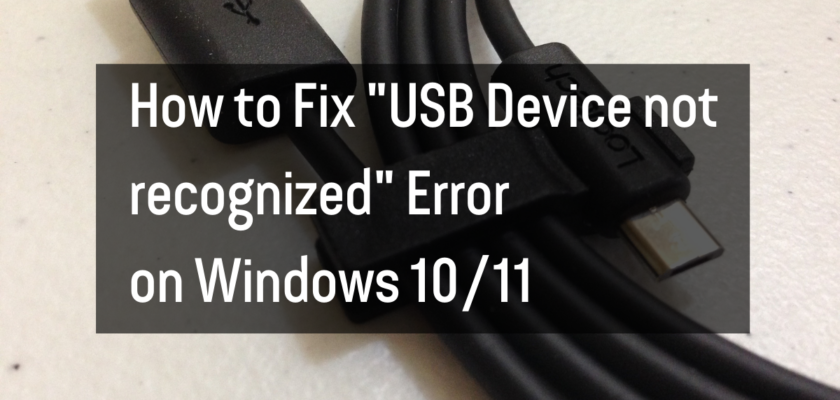If you’re using Windows 10 or Windows 11 computer and have connected a USB device, such as a printer, external hard drive, or camera, you may have encountered the “USB Device not recognized” error.
This error message can be frustrating, but fortunately, there are several steps you can take to troubleshoot and fix the problem.
If you want to read an overview, history, USB device classes, etc., you can find all this information here.
Now let’s understand why this error occurs.
The “USB Device not recognized” error is typically caused by a problem with the drivers for the USB device. When a USB device is connected to a computer, the operating system uses a driver to communicate with the device and properly use its features. If there is a problem with the driver, the operating system may not be able to recognize the device and display the error message.
Here are some steps you can take to fix the “USB Device not recognized” error on your Windows 10 or Windows 11 computer:
Restart your computer.
Sometimes, simply restarting your computer can fix the problem. After the restart, reconnect the USB device and see if the error still appears.
Check for Windows updates.
The “USB Device not recognized” error can sometimes be caused by outdated drivers or operating system files. To check for updates, go to the Start menu and select “Settings.” In the Settings window, click on “Update & Security” and then select “Windows Update.” If any updates are available, install them and then try reconnecting the USB device.
Update the drivers for the USB device.
As mentioned above, the “USB Device not recognized” error can be caused by outdated drivers for the USB device. To update the drivers, go to the Start menu and type “Device Manager” in the search box. In the Device Manager window, find the USB device that is causing the problem and right-click on it. Select “Update driver” from the menu and follow the on-screen instructions to install the updated driver.
Uninstall and reinstall the drivers for the USB device.
If updating the drivers didn’t fix the problem, you may need to uninstall and reinstall the drivers. To do this, go to the Start menu and type “Device Manager” in the search box. In the Device Manager window, find the USB device that is causing the problem and right-click on it. Select “Uninstall device” from the menu and then confirm the uninstallation. After the drivers have been uninstalled, disconnect the USB device and then reconnect it to your computer. The operating system should automatically reinstall the drivers and hopefully fix the “USB Device not recognized” error.
Try a different USB port.
If you’re still having trouble, try connecting the USB device to a different USB port on your computer. Some USB ports may be malfunctioning or not working properly, so switching to a different port can sometimes fix the problem.
Try a different cable.
The cable that you’re using to connect the USB device to your computer may be the source of the problem. Try using a different cable, or try using the cable with a different device to see if the cable is the issue.
Reset the USB controllers.
If none of the above steps have worked, you may need to reset the USB controllers on your computer. To do this, go to the Start menu and type “Device Manager” in the search box. In the Device Manager window, expand the “Universal Serial Bus controllers” section and then right-click on each USB controller. Select “Uninstall device” from the menu and then confirm the uninstallation. After the USB controllers have been uninstalled, restart your computer and the operating system will automatically reinstall the controllers.
If you have followed all of these steps and the “USB Device not recognized” error still appears, you may have a hardware problem with your USB device. In this case, it might be best to take the device to a repair shop or replace it if possible.
Note: If your computer’s USB port is physically damaged, none of these steps will work. You’ll need to get a new USB port installed by a technician to use the device again. Be sure to back up all important data before taking it for repair.
Thanks for reading this article. Good luck!

